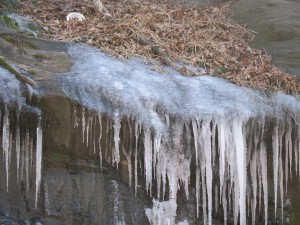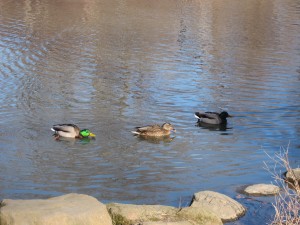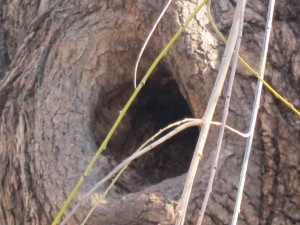Hunting for Central Park’s Black Squirrels
UPDATE, March 2012: I finally succeed in spotting one of New York City’s lovely black squirrels. Not in Central Park but in Washington Square Park: Black Squirrel in NYC.
A fellow nature lover recently told me of seeing a black squirrel repeatedly in the northern end of Central Park.

Black squirrel in Central Park. Photo courtesy of Gigi A.
The squirrel usually seen in NYC parks is the Eastern gray squirrel, Sciurus carolinensus. Eastern grays love hardwood forests that provide them with acorns, berries, bark, insects and tree buds. In the old days, before the virgin forests of the east were cleared, it was said that a squirrel could travel the entire east coast in the treetops, without ever touching ground.
And travel Gray squirrels did, and sometimes, perhaps, still do. Audubon and other early American naturalists called it the Migratory squirrel for its mass migrations through the trees, which Charles Joseph Latrobe described in 1811:
“A countless multitude of squirrels, obeying some great and universal impulse, which none can know but the Spirit that gave them being, left their reckless and gambolling life, and their ancient places of retreat in the north, and were seen pressing forward by tens of thousands in a deep and sober phalanx to the South …”
Other nineteenth century writers describe Gray squirrel migrations that lasted up to four weeks and involved hundreds of thousands of animals.
Today’s Gray squirrels live in whatever wilderness remains to us, while also thriving in the suburbs and in urban parks. Black squirrels, according to most researchers, are a melanistic color morph, or variation, of the Gray squirrel, the color resulting from an excess of melanin, a dark pigmentation. Essentially, black squirrels are simply black Grays.
I’d heard of black squirrel populations in other parts of NYC, including Union Square Park and the grounds of Stuyvesant Town and Peter Cooper Village. City parks can be like islands, separated by streets instead of water, where inbreeding leads to swift manifestation of unusual genetic traits, including melanism. Was a nascent population of black squirrels emerging in Central Park? I decided to go squirrel hunting.
The morning glowed with sunlight that failed to warm.

Central Park boulder sporting icicles.
Despite the bitter cold, someone appeared to be meditating on a point of land that jutted out into the still-unfrozen Pool, the little pond at 101st Street.

A peaceful moment.
A mixed flock of ducks paddled about, and a few came over to see if I was offering food. (I wasn’t.)

Who gets the girl?
The stretched-out neck of one of the male Mallards is a behavior called ‘steaming’ and is one of many Mallard courtship displays. The ducks are already pairing up in preparation for spring nesting.
Across the Pool, Buffleheads, a particularly adorable duck species, dove and surfaced, flashing their big white heads and sides.

Quick-diving ducks: Now you see them, now you don’t.
Buffleheads, like scaup, mergansers and canvasbacks, are diving ducks, capable of swimming underwater to feed, while Mallards, like American wigeons, teals and shovelers, are dabbling ducks, tipping up their tails to feed with their heads underwater. Mallard ducklings regularly dive underwater to avoid predators, although duckling predators also include water dwellers, like snapping turtles and fish.
But I digress. A good walk makes for many digressions. I resumed my hunt for the black squirrel, heading south through the park all the way down to 89th Street.
Along the way, I saw a huge flock of Common grackles. (Birder friends, these are grackles and not some kind of blackbird, yes?)

Just a small corner of a much larger flock.
The flock was accompanied – or, perhaps, infiltrated – by a solitary bluejay.

One thing is not like the others.
I saw perfect squirrel hideouts.

Anyone in there?
I saw squirrel dreys, or nests, including this one high in a tree.

Apartment with 360-degree view
And, inevitably, I saw squirrels. Just a few, due to the cold, and all of them normal Grays, like this little fellow in the fork of a tree.

Gray squirrel keeps an eye on the passing world.
So I’m still looking for my first black squirrel.
When I returned home, I discovered that while I was traipsing the Park’s north end, a black squirrel had been hanging out down at the southern end, near Wollman Rink.

Black and Gray, just chillin.’ Photo by Gigi A.
Meanwhile, I’ve learned from a favorite naturalist in England that across the Big Pond, in the U.K., black squirrels are a source of serious controversy. All Gray squirrels are considered an invasive species there, as they drive out the native red squirrel population. But there’s something about black Grays that … well, more on black squirrels in a future post. Meanwhile, do let me know if you see any unusual squirrels around your neck of the woods.
Explore posts in the same categories: 2012, Central Park, In the City, NYC Parks, Seasons, Squirrels, Wildlife/Natural History, WinterTags: black squirrels, black squirrels Central Park, black squirrels NYC, Central Park mallards, duck swimming with stretched-out neck, ducks Central Park, gray squirrels, NYC squirrels, squirrel hunting NYC, urban squirrels
You can comment below, or link to this permanent URL from your own site.
December 26, 2020 at 12:36 am
There are black squirrels in the northwest quadrant of Central Park, in Morningside Park, on the grounds of the Cathedral of St. John the Divine, and in Marcus Garvey Park in Harlem. I have seen black squirrels in these locations for decades. Interested to learn about the population in Washington Square Park and in City Hall Park.
December 26, 2020 at 9:30 am
Thanks for your comment, Michael. Does it seem to you that the black squirrels have become more numerous over the years?
May 9, 2014 at 2:23 pm
I live in Queens and have a black squirrel who comes to my yard everyday to get its walnut….or two or three. He (or she) has been coming for two years now, running right up to me when it sees me. It’s my favorite squirrel to see. I feed the grey ones too, but only peanuts….couldn’t afford to feed walnuts to all of them.
September 30, 2013 at 7:35 am
[…] readers may recall my quest to find one of New York City’s black squirrels, and my thrill when I finally came across a […]
April 3, 2013 at 11:12 am
I have seen black squirrels in past visits in the very southwest corner of Central Park. Will be visiting this weekend so will search for them!
April 3, 2013 at 2:13 pm
Hello Jay, Thanks for the comment. Stop back and let us know how your Central Park walk went, and whether you saw any more black squirrels.
March 25, 2013 at 7:13 pm
[…] year ago, I went hunting for black squirrels in Central Park, but to no avail. Then in January, I finally spotted one as I walked along the south side of […]
February 26, 2013 at 11:36 am
PS Just read that they were actually introduced by a Kent State biologist, not a grounds supervisor( perhaps they were working together on the project) to test whether the local ecosystem would be affected by the introduction of the black squirrel.
March 1, 2013 at 6:56 pm
Hmmm. Sounds like a good way to launch an environmental disaster – although mitigated, perhaps, by the fact that the black squirrel is not a separate species but a color morph of the gray.
February 26, 2013 at 11:31 am
Hello, I was just preparing a post about our black squirrels and found you while researching. Ours were legally imported from Canada to Kent State University by a grounds supervisor in the 1960’s. We live 30 miles north of Kent and our area of Northeast Ohio is full of them. Never knew to look for them in NYC! Will tell our daughter who lives on the UWS to be on the lookout!
March 1, 2013 at 6:38 pm
Great! I look forward to reading your post. I have yet to see a black squirrel anywhere on the upper west side, but I did recently see my first NYC black squirrel down at Washington Square in the Village. Pretty little guy.
January 13, 2013 at 4:34 pm
Just returned from a vacation in NY, see a black squirrel whilst walking to the museum, just behind the wall in central park proximity to: E 70th Street.
January 13, 2013 at 4:41 pm
Lucky! I’m jealous, but will just have to keep my eyes open. Thanks for the tip.
October 3, 2012 at 3:38 pm
There’s something very curious about squirrels for me.
Whenever I see them, I don’t know why, but I just start to feel joyful!
Do you get the same feeling or is it just me?
January 29, 2012 at 3:52 am
I come from a small village near Cambridge, UK and was in NYC to sing at Karl Jenkins world premier of ‘The Peacemakers’ at Carnegie Hall, . We stayed colse to Central Park, and so were walking there on 14 January. Adjacent to the Balto statue the first squirrel I saw was a black one. I was expecting grey ones like in the UK – the imported greys have killed off their smaller cousins the red squirrel, which can now only be found in isolated pockets in the north of England and Scotland. It was a real bonus on what was my first visit to NYC.
January 29, 2012 at 9:54 am
What a wonderful reason to come to NYC, Suzie! I hope the city welcomed you and your fellow singers – as the black squirrel seems to have done. I plan to write a piece on the squirrel situation in the UK soon – a pretty dramatic invasion. Thanks for visiting Out Walking the Dog.
January 28, 2012 at 5:24 am
I used to see a black squirrel in the area around where the 102nd St transverse meets the west side of the Central Park loop, not far from where the female screech owl’s regular roost was located. But that was a few years ago. IIRC there may have been another hanging around a couple blocks further north near the upslope of the road over the Great Hill.
Also used to encounter a black squirrel in Morningside Park not far from the upper 113th St. entrance. That was more recent, but still a couple years ago. That guy was the boss of the neighborhood.
January 26, 2012 at 9:55 am
Urban squirrels are adorable unless they are in your attic chewing your electric wires, or waking up in the attic just when you’re going to bed and crumbs of ceiling fall on your face.
However, when I lived in Toronto and worked a the local mental health centre, there was a wonderful group of white squirrels. “Native lore” claimed this was because the patients fed their meds to the squirrels who loved to cadge a meal at any opportunity and would beg if it was required, sitting up so pretty on their little haunches. As far as I know there is one other site in Toronto where the black/grey squirrel has turned white, and not because of anti-psychotic meds. So all this makes me wonder if they somehow didn’t have enough exposure to whatever caused the grey squirrels to turn black? Whatever, they really were cute wee guys, and some day if I return I’ll get a photo to send you. Great post! Like the meditator a lot…
January 27, 2012 at 12:16 pm
Barbara, I had major problems with fox squirrels when I lived in Dallas, Texas. They got into several different parts of the attic, and held major parties in there. I think there was a rave up there one day, and a dj on another occasion. I mean, this got serious! We finally hired people to help evict them, and then sealed the holes. Crazy little guys.
As for white squirrels, a reader posted a link on Out Walking the Dog’s Facebook page to a town in Southern Illinois with a white squirrel population (no medications involved). I think the Toronto white squirrels may be another example of how a genetic trait can be spread more swiftly within the somewhat isolated squirrel populations of city parks. Would love a photo!
I liked the meditator, too. So peaceful and still …
January 25, 2012 at 9:19 am
I’ve seen a nice little population of black squirrels in Inwood Hill Park…and Grand Haven, Michigan… but I digress! ;-)
January 26, 2012 at 8:04 am
I’ll try Inwood, maybe pass on Grand Haven for the moment – I think it’s off the subway line.
January 25, 2012 at 12:01 am
I realize that we must go on a walk together the next time I am in NYC…I love squirrels! They are one of my absolute favorite animals…we have these adorable squirrels which are only found here in the Ponderosa pine forest near flagstaff…They grow these wonderful tassel’s on their ears in the colder months when they are out and about trying to remember where their “stash” of food is…mostly they eat the tassels from the Pine trees…lol..:D
http://fireflyforest.net/firefly/2008/05/29/aberts-squirrel/
January 26, 2012 at 8:03 am
Those Abert’s squirrels are awfully cute. So those tassles are only in winter – very stylish. Thanks for the link – and you can look for more squirrel posts coming up.
January 24, 2012 at 11:32 pm
I also have a fascination with the black squirrel. I live in Boston, but last spring I visited the botanical gardens in the Bronx and saw tons of the squirrels in the green space around the perimeter of the gardens. After I’d seen three or four of I figured I was just dreaming, but then I got a good, clear view of a fifth and surrendered myself to the wonderful fact that I was in some sort of black squirrel wonderland. It was marvelous – you should check that area out!
Also – I am just starting to write more about urban ecology in earnest and am absolutely pleased to have found your blog.
January 26, 2012 at 8:01 am
Thanks, Jenny. I haven’t been up to the Botanical Gardens in the Bronx in years – will have to check it out.
January 24, 2012 at 9:02 pm
There are “blonde” Fox Squirrels on the campus of the University of Texas in Austin. Their fur has only the smallest amount of pigmentation. They appear to be very nearly white. But, their eyes are fully pigmented, and colored the same dark brown as you would find on a more ordinary squirrel!
January 26, 2012 at 8:00 am
Interesting, CGJ. So many possibilities in nature. Once one starts looking, “normal” starts to seem like just one more variation on a theme.
January 24, 2012 at 4:38 pm
Love this post — just great!
January 24, 2012 at 1:20 pm
Take a look along the path on the far side of Turtle Pond. I often see black squirrels there. There are also black squirrels in Washington Sq. Pk.
January 24, 2012 at 2:31 pm
Thanks, Melody. I don’t know how it is I never see these little guys! When you say “far side of Turtle Pond,” which side do you mean?
January 24, 2012 at 11:22 am
Fascinating that some squirrels used to migrate! I never knew that. And I didn’t know that about the diving/dabbler ducks either, although I’ve watched both types. It never registered in me head. I learn something new everyday! Yay!
January 24, 2012 at 2:45 pm
Yes, it is pretty wild to imagine a squirrel migration overhead. I’m actually still trying to decipher whether these mass movements are migrations (the animals return in another season to their starting point) or emigrations (a one-way ticket to a new destination). Don’t know the answer yet. Squirrel experts??
January 24, 2012 at 10:33 am
I find that rarely do I come across what I’ve gone out to specifically look for, yet the journey is what is important, not the destination and I always see something interesting on the way!
Hope you and Esau come across a black ‘gray’ soon.
January 24, 2012 at 2:46 pm
I couldn’t agree more about the journey being what’s important. Life would be awfully dull if we always found exactly what we’re looking for.
January 24, 2012 at 10:07 am
I walk across the park I enter at 97 and Fifth and walk west. I saw a black squirrel closer to the west side- right before I exited at Central Park West probably past that recreation center at the back end of the North Field ball parks.
January 24, 2012 at 10:13 am
That’s one of the spots my informant has seen a black squirrel, and where I’ve been looking. Will have to try again. Thank you for the tip, Linda.